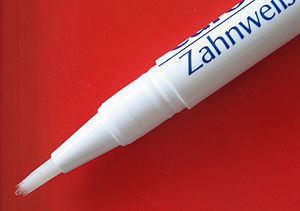Source: http://en.wikipedia.org/wiki/Tooth_bleaching
Dental bleaching, also known as tooth whitening, is a common procedure in general dentistry but most especially in the field of cosmetic dentistry. A child's deciduous teeth are generally whiter than the adult teeth that follow. As a person ages the adult teeth often become darker due to changes in the mineral structure of the tooth, as the enamel becomes less porous[citation needed]. Teeth can also become stained by bacterial pigments, foodstuffs and tobacco. Certain antibiotic medications (like tetracycline) can also lead to teeth stains or a reduction in the brilliance of the enamel...
...The side effects that occur most often are a temporary increase in tooth sensitivity and mild irritation of the soft tissues of the mouth, particularly the gums.[15] Tooth sensitivity often occurs during early stages of the bleaching treatment. Tissue irritation most commonly results from an ill-fitting mouthpiece tray rather than the tooth-bleaching agent. Both of these conditions usually are temporary and disappear within 1 to 3 days of stopping or completing treatment.
Wednesday, July 28, 2010
Subscribe to:
Post Comments (Atom)




No comments:
Post a Comment